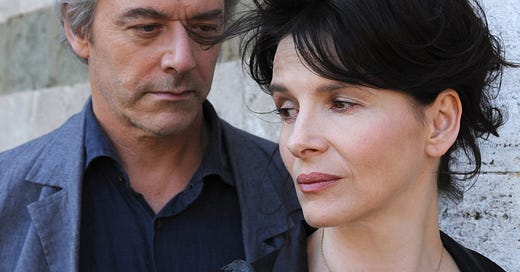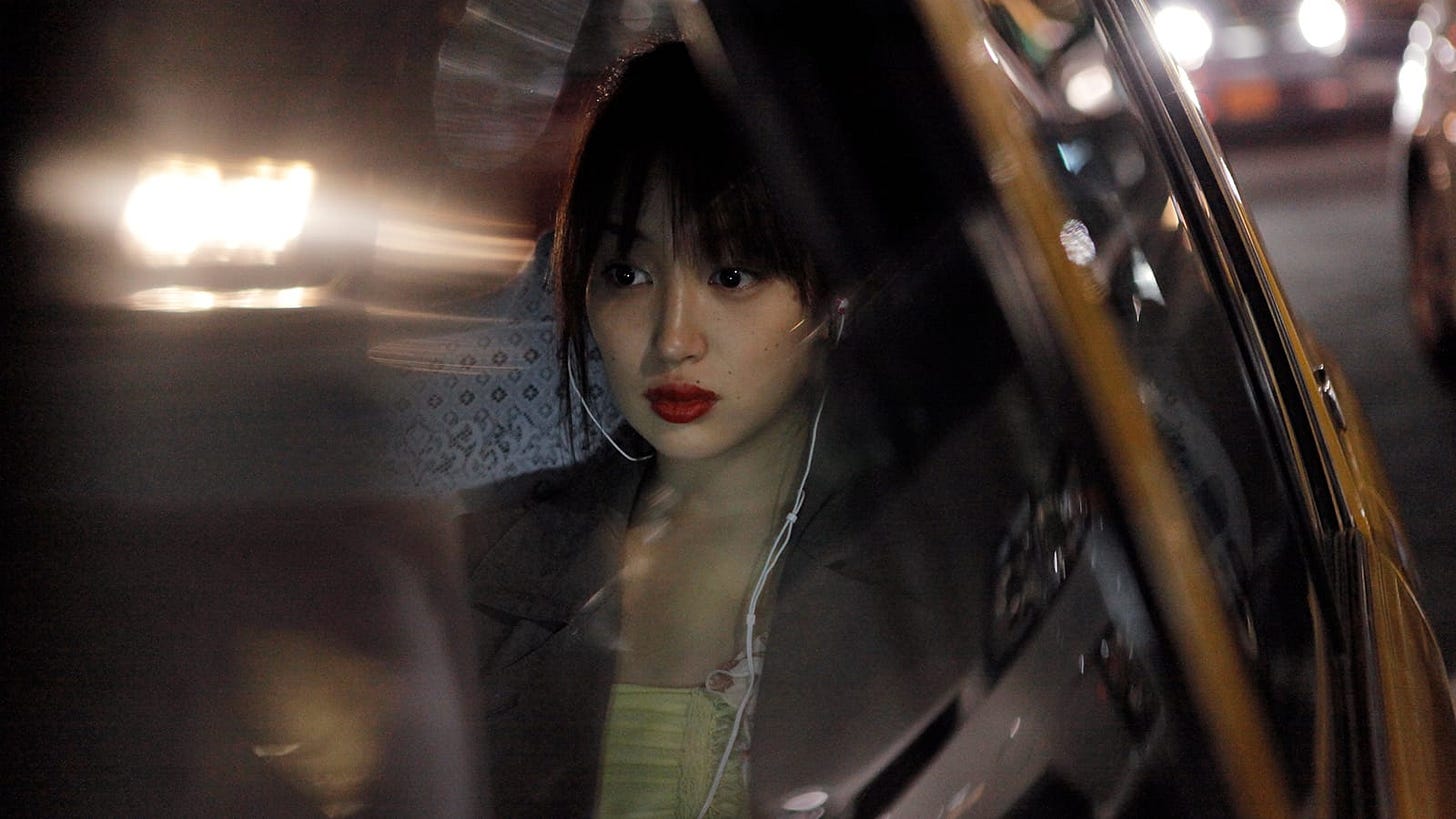Abbas Kiarostami day 2: Certified Copy (2010) + Like Someone in Love (2012)
Saturday 15th of March, 12:30-5:20pm in the Richard Hoggart Building cinema
Join us on Saturday the 15th of March from 12:30pm (first film starts at 1pm) in the Richard Hoggart Building cinema for our second double bill of films by the key Iranian filmmaker Abbas Kiarostami. At 1pm we will show Certified Copy (2010), which will run for 1 hour 46 minutes and finish at 2:50pm. After a 40-minute break we will show Like Someone in Love (2012) at 3:30pm, which will run for 1 hour 49 minutes and finish at around 5:20pm.
Abbas Kiarostami is the most famous and internationally acclaimed director of the Iranian New Wave, and one of the most important directors in world cinema over the past fifty years. As part of our term-long exploration of Iranian cinema, we are showing four of his films. On Saturday the 1st of February we screened his Close-Up (1990) and Taste of Cherry (1997), following on from the Koker trilogy last year.
Certified Copy was Kiarostami’s first film made outside Iran. The Criterion release describes it as “a luminous and provocative romance in which nothing is as it appears. What seems at first to be a straightforward tale of two people—played by Oscar-winning actress Juliette Binoche and opera singer William Shimell—getting to know each other over the course of an afternoon gradually reveals itself as something richer, stranger, and trickier: a mind-bending reflection on authenticity, in art as well as in relationships. Both cerebrally and emotionally engaging, Certified Copy reminds us that love itself is an enigma.”
According to Godfrey Cheshire:
To be sure, the film is recognizably Kiarostamian in many particulars, such as its use of long takes of extended conversations in automobiles and alleyways. But as a type of film, with its desultory chronicling of an implicitly romantic but also querulous and cryptic encounter between two very attractive middle-class intellectuals—an English writer and a French antiques dealer—who discuss art and life and their own peculiar travails against the irrepressibly picturesque stones and vistas of Tuscany, Certified Copy looks not only like a European art film but also like a specific subgenre of that form that was proudly exported, especially by France and Italy, from the fifties through the seventies.
No wonder some reviewers were restrained in their praise. Critics exist to supply definitions of artists, and the standard definition of Kiarostami has had far more to do with his cerebral Iranian-ness (however that is described) than with an affinity or kinship with any genus of European art cinema, especially one now effectively outmoded. For audiences, on the other hand, that correspondence was no handicap at all; quite the contrary, by all evidence. Certified Copy became an art-house hit across the West, Kiarostami’s highest-grossing film ever. And if audiences in America, say, were drawn to it by trailers promising a certain kind of Juliette Binoche film rather than any kind of Kiarostami film, what of it? When the box-office results were in, it was clear that Kiarostami had made another nervy leap and landed on his feet. With the advantage of some extra hindsight, it’s possible to add that those initial critical reactions had it only half-right: hidden beneath the alluring surface of a movie that confidently revives the conventions of a certain kind of European art cinema, there’s a quintessential Kiarostami film, one of the most deeply personal he has made.
Criterion says that Like Someone in Love “may appear to be among his most straightforward films. Yet with this simple story of the growing bond between a young student and part-time call girl and a grandfatherly client, Kiarostami has constructed an enigmatic but crystalline investigation of affection and desire as complex as his masterful Close-up and Certified Copy in its engagement with the workings of the mercurial human heart.”
For more on Like Someone in Love, see Nico Baumbach’s essay:
Many of Abbas Kiarostami’s narratives hinge on some form of dissimulation, on acting like. To offer only a few examples: in The Traveler (1974), a boy acts like a photographer, using a camera with no film in it to collect money to buy a ticket to see a soccer game that he will eventually miss because he oversleeps; in Where Is the Friend’s Home? (1987), a young boy, after failing to return the notebook that a friend left behind, will forge the friend’s homework, an act of generosity that will lead to a moment of grace; in Close-up (1990), a film that is both a real and simulated documentary, an unemployed man is accused of pretending to be a filmmaker to take advantage of a family whom he told he was going to make the subject of a film. Dissimulation in each of these works is about testing the limits of authority, social demands, and expectations.
In all of Kiarostami’s films, these games of simulation and dissimulation, likeness and play, are carried over from the protagonist to the spectator. One of the central gestures of his work is to create a relation to the film in which the spectator’s experience will mirror the character’s plight, which always means opening up a gap between the world (the social world but also the world of the film) and the viewer’s desires and revealing the subversive potential of appearance, of semblance, of being like. Kiarostami has suggested that this involves making the spectator the author of the film, which for him also means making the filmmaker something of a spectator.
The figure of filmmaker as spectator takes on a new resonance in the two films made outside of Iran. Kiarostami has always been invested in ways of seeing made possible from a position of not knowing where we are or what or whom we are looking at. Making a film in Italy or Japan, an unknown country, in a language he doesn’t speak, heightens in a new way the sense of the filmmaker as spectator, which in turn makes the audience more like creators, placed in a similar relationship of discovery as the filmmaker. This experience, we should be clear, should not be confused with familiar themes associated with the “art film,” such as alienation or ambiguity for its own sake, but rather it becomes the condition for an emotional connection that otherwise would not have been possible. It is also related to the profound political dimension of his films.
The tension between being and appearance in Kiarostami’s work has always been a way of challenging institutions and social expectations, whether related to education, work and class, the law, or cinema. Some of his Iranian features have also explicitly focused on love and romance (Through the Olive Trees, 1994) and on women’s experience (Ten, 2002; Shirin, 2008), but the regulated system of modesty since the 1979 Islamic Revolution meant that linking these themes was possible only through subtle displacements. Which brings me to another significant aspect of Kiarostami’s two films made abroad. They seem to have afforded him the opportunity to focus less discreetly than he has before on the figure of the couple in relation to norms of intimacy, the institution of marriage, by way of the question of love. In Like Someone in Love, especially, while making a film as an outsider meant in some ways a greater distance from the world and culture he was depicting, it also made possible a deeper probing of desire in its most physical dimension. This may be both Kiarostami’s most sensual and his most violent film.



